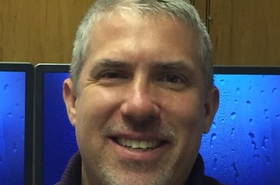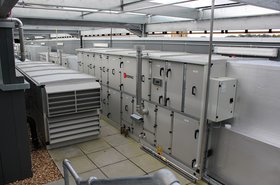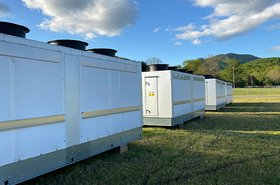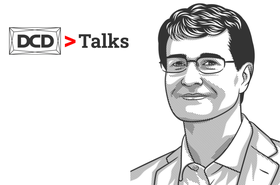Data centers are getting denser, much denser. In 2017 a majority of operators – 67 percent – reported an average rack density of below six kilowatts (kW), and just nine percent had average densities of over 10kW per rack according to numbers from the Uptime Institute.
But as of 2022, the average rack density has crept up to eight to ten kW per rack. Meanwhile, 25 percent of data centers are now reporting rack densities of over 20kW, and five percent now have densities north of 50kW.
Some analysts have even predicted that by 2025, average densities could reach 15 to 20kW per rack. While multi-story developments have become increasingly common, the growing densities may limit data centers in the future to one or two stories in order for the heat rejection equipment to fit on data center roofs.
This trend of denser data centers is unlikely to disappear soon. Many of the areas that need data the most are getting much stricter in terms of how they issue planning permissions. For instance, due to concerns about the capacity of Ireland’s grid, the country’s national electricity grid operator – Eirgrid – has stopped issuing new connections to data centers in the Dublin area until 2028.
Of course, larger, denser data centers are now producing more raw heat than ever, which, with space being at a premium, can often mean less room to accommodate the cooling systems required to tackle such loads.
DCD spoke to industry stalwart Keith Dunnavant of Munters, a global specialist in energy-efficient air treatment and climate solutions, to find out how the company’s award-winning cooling system, SyCool Split, can help operators keep their cool, no matter the size of their facility.
A problem shared
With a split system approach to cooling units, Dunnavant explains, you only have to deal with the heat absorption component of the cooling process from inside the building. The heat is transported by water or refrigerant piping to external heat rejection equipment, installed on the roof or around the building perimeter, where ultimately the heat is rejected into the ambient air.
“Having the heat absorption process decoupled from the heat rejection process is the most space-efficient and practical approach to accommodate rising heat densities. Compared to packaged air-handling units, large ductwork is replaced by relatively small interconnected piping.
“In the case of air cooling, it's practically impossible to move all the hot air to package units, and deliver the cooled air back down to the data halls, once you get above a two-story data center,” says Dunnavant.
In the Munters SyCool system, there is a separate indoor evaporator (heat absorber) and an outdoor condenser (heat rejector). A low GWP (Global Warming Potential) refrigerant – a type of working fluid used to transfer energy – flows into the evaporator in a liquid state.
As the hot air or liquid from the data center flows through the heat exchangers within the SyCool air-handler (CRAH) or LCEs (Liquid Cooling Evaporators), the liquid refrigerant changes phase to a vapor. This vapor flows up through pipes (risers), transporting the heat up to the condensers where the heat is rejected into the atmosphere, converting the vapor refrigerant back to a liquid, and allowing gravity to transport the liquid through “downcomer” pipes back to the evaporators to begin the cycle over again.
This process of moving heat naturally, by phase change and gravity, is called a thermosyphon. Thermosyphons are an energy-efficient approach to heat exchange, since they require no pumps and offer other benefits compared to more conventional chilled water approaches.
“Thermosyphon technology is not new, it's been around for quite a long time. However, Munters is the first to apply the technology to data center heat rejection at large scale,” Dunnavant explains.
“Normally in the classic example, where the condensers are on the roof, the refrigerant flows up to V-shaped banks of coils that ambient air is drawn over using axial, variable speed fans, to condense thermosyphon vapor refrigerant to a liquid.”
There are two methods for condensing vapor refrigerant back to a liquid with SyCool: a) when the ambient air is cool, thermosyphon condenser coils perform the work (passive condensing) and b) as the ambient air dry-bulb temperature exceeds the economizing threshold, brazed plate heat exchangers (active condensers) perform the work.
The active condensers have conventional DX refrigeration on one side of the brazed plate heat exchangers, to absorb the heat from the thermosyphon refrigerant, which flows through the opposite side of the heat exchanger, where the vapor is condensed back to a liquid. The active condenser begins assisting with the condensing process as needed, as the outdoor air temperature rises.
Advantages of this approach are: a) there are no pumps required to circulate what's called the working fluid, the refrigerant, as this process takes advantage of the physics of phase change and gravity, b) the working fluid is not at risk of freezing (a concern for water-based systems in cold climates), c) the approach is modular – installed in 125kW, 250kW, 400kW, 500kW, or 800kW (future) blocks – and scalable to accommodate future demand. D) the economizer is superior to most other strategies, allowing compressors to remain off for many annual hours, keeping energy costs low. Additionally, as there are no pumps, there are fewer potential points of failure, enhancing reliability.
“Chilled water plants are now commonly used to cool large data centers, especially colos, and chillers using magnetic bearing compressors operating at high suction temperatures are quite efficient. However, the economizers (when included) paired with these chillers are often inefficient, forcing compressors to run until outdoor temperatures drop below about 40F, or continuously when there is no economizer. Additionally, the chilled water plant’s extensive piping, valves, pumping systems, and controls are both complex and expensive.”
A real pending issue, says Dunnavant, “is that as we move towards data centers utilizing both air and liquid cooling, the chilled water temperature must usually be selected to meet the needs of the air cooling, and is often suboptimal for liquid cooling. This is acceptable if liquid cooling is a small portion of the total, however, as the fraction of liquid cooling increases, the lost energy savings that could result from operating using warmer water temperatures begin to add up.”
With SyCool, each matched evaporator and condenser pair uses factory controls that operate optimally for each environment, either air or liquid cooling.
Cooling in a hotter world
Many modern data centers are required to operate under increasingly hot conditions. 2023 was the hottest year on record worldwide, and many data centers in key metropolitan areas such as London suffered outages, in part, because of their inability to cool effectively under the strain of record heat wave temperatures.
According to Dunnavant, another advantage of SyCool’s design is an abundance of heat transfer surface area in the external hardware.
“This allows you to achieve an economizer that can provide 100 percent of the cooling at really elevated ambient air temperatures. If you're trying to cool air at 95 Fahrenheit to 75 Fahrenheit, you can typically do that when the outdoor air temperature is in the low 60s Fahrenheit or below.
“A typical waterside economizer, that's integral to a chiller, is not able to do that until it's around 40 degrees Fahrenheit or below. The SyCool cycle can reject the bulk of the annual cooling load without using compressor energy, which can save substantial electrical power on an annual basis.”
Reducing energy consumption is of growing concern for data center operators, both for economic and sustainability reasons, and now also to reduce the strain on an aging electrical grid. In 2023, we’ve seen countries such as Germany and the UK push out regulations demanding energy efficiency standards from data center operators.
Ultimately, as the challenges of data center cooling continue to shift, the industry can certainly benefit from looking towards new methods of attacking these issues. Not only in terms of cost savings and efficiency, but the effective rejection – and potential reuse – of heat from these facilities in order to create a more sustainable industry.
To find out more about Munter’s SyCool system please visit munters.com.
More from Munters
-

-

Munters acquires Irish cooling equipment manufacturer EDPAC
Munters targets expansion in Europe after closing EMEA data center equipment factory in 2019
-

Sponsored Munters moves to new Virginia factory, as data center business grows
Relocates staff 40 miles to Botetourt County to meet increased demand

